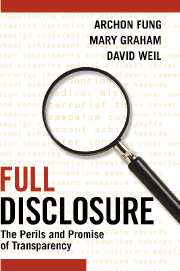Book contents
- Frontmatter
- Dediaction
- Contents
- List of Figures and Tables
- Preface
- 1 Governance by Transparency
- 2 An Unlikely Policy Innovation
- 3 Designing Transparency Policies
- 4 What Makes Transparency Work?
- 5 What Makes Transparency Sustainable?
- 6 International Transparency
- 7 Toward Collaborative Transparency
- 8 Targeted Transparency in the Information Age
- Appendix: EighteenMajor Cases
- Notes
- Bibliography
- Index
3 - Designing Transparency Policies
Published online by Cambridge University Press: 27 July 2009
- Frontmatter
- Dediaction
- Contents
- List of Figures and Tables
- Preface
- 1 Governance by Transparency
- 2 An Unlikely Policy Innovation
- 3 Designing Transparency Policies
- 4 What Makes Transparency Work?
- 5 What Makes Transparency Sustainable?
- 6 International Transparency
- 7 Toward Collaborative Transparency
- 8 Targeted Transparency in the Information Age
- Appendix: EighteenMajor Cases
- Notes
- Bibliography
- Index
Summary
IMPROVING ON-THE-JOB SAFETY: ONE GOAL, MANY METHODS
Federal and state governments in the United States have grappled with the problem of occupational safety and health in various ways for more than a century. As far back as 1916, John R. Commons, one of the first social scientists to study and help design workplace regulations, commented:
Prominent among the problems which the Industrial Revolution brought in its wake is that of maintaining safety and health in workplaces. As long as industry was chiefly agricultural, or carried on about the family hearth, with tools relatively few and simple, the individual laborer might control the physical conditions under which he worked.
The range of government responses to the problem of safety in the newly industrialized workplace has made this area a kind of real-world laboratory in which differing policy approaches to the same broad objective may be observed and compared. These include, most recently, targeted transparency.
Early factory laws in the United States, beginning with one enacted by Massachusetts in 1886, created dedicated agencies to reduce the toll ofworkplace fatalities and serious injuries. These early regulatory systems relied on enforcement of specific safety standards (such as requirements for safety shields on machinery or limits on the amount of dust in the air). They also raised questions about regulatory design that have long since become familiar to policymakers and the general public – questions like these:
• What safety standards should be adopted to improve workplace conditions?
• How many inspectors should be hired, and what skills and training do they need?
• To which industries and workplaces should inspectors be sent, and what should they do once there?
• What penalties should be assessed when violations are detected?
• How should repeat offenders be treated?
As workplace health and safety problems persisted, legislators devised additional regulatory approaches to augment standards-based systems. The most striking example was workers compensation insurance, adopted first by Maryland in 1902 in the form of a cooperative insurance law covering a narrow set of industries.Workers compensation systems provide benefits to injured workers by requiring companies in specified industries to pay into a common insurance fund. Premiums paid into the system by firms varied both by industry and by the employer's prior injury performance. This system of “experience rating” was intended to create financial incentives for employers to improve safety practices.
- Type
- Chapter
- Information
- Full DisclosureThe Perils and Promise of Transparency, pp. 35 - 49Publisher: Cambridge University PressPrint publication year: 2007
- Creative Commons
- This content is Open Access and distributed under the terms of the Creative Commons Attribution licence CC-BY-NC 4.0 https://creativecommons.org/cclicenses/



